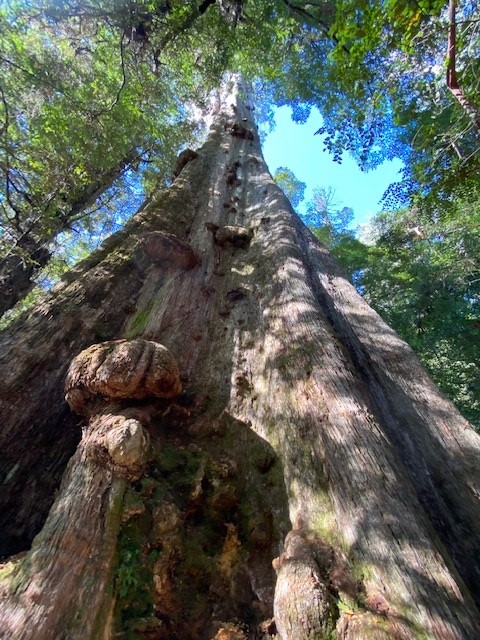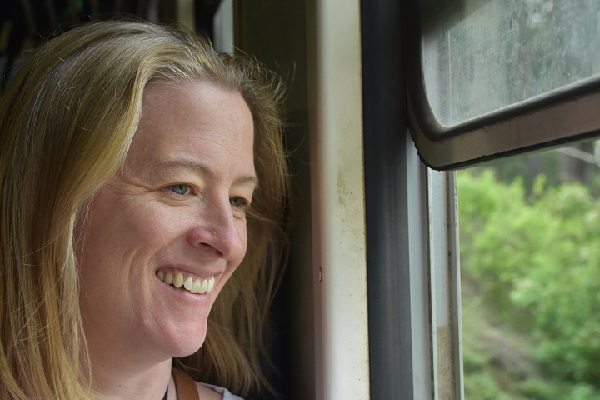What Bob Brown teaches us about leading change
In this post I reflect on the life story of Bob Brown as shown in documentary The Giants (currently screening) and what he teaches us about leading change.
This photo was taken on a family visit to Tasmania’s Styx Valley in 2022 which is the home of Eucalyptus regnans, the tallest flowering plant on Earth. To stand in the presence of these giants, which have stood for more than 400 years, is nothing short of magical. They can’t help but to widen one’s perspective. I am deeply grateful to know that these beautiful trees are no longer under threat.
Humans and nature are inextricably linked. One person who perhaps knows this better than many is environmental activist, former politician, and Greens co-founder, Bob Brown. Last week, I had the privilege of seeing The Giants, a documentary recounting the personal story of Bob and his lifetime commitment to conservation. I was deeply stirred and inspired at multiple levels, so much so that I couldn’t get on with any other work/anything else until I shared this with you!
A qualified doctor, Bob walked away from his profession to follow what could be described as a ‘calling’ or a ‘knowing’ within himself, imploring him to attend to something greater. He has spent all his years since as a staunch activist for the protection of Australia’s wilderness, including his significant role in the infamous Franklin Dam protests and his 29 years in state and federal politics, during which he co-founded the Greens party.
Given much of my own work is about ‘leading change’ at a personal and systemic level, I couldn’t help but view The Giants through this lens, and I am so glad that I did. Bob’s actions and way of being in the world were well ahead of his time. Through viewing his story in its entirety, I was able to witness some of the qualities that guided his actions as a remarkable leader and changemaker.
1. He got ‘out of the way of himself’ and found his voice.
Bob was quiet by nature as a child and didn’t like public speaking. However, early on he had an ‘ah-ha’ moment that would compel his future actions: this wasn’t about him, it was about speaking on behalf of the trees.
We can so often let the ‘I’ get in the way of the collective good. When we show up in service of something greater than ourselves, particularly if it is in alignment with who we are and what we are here to do, then all manner of things can shift to help us on our path. Speaking up and challenging the status quo is often the birthplace of change. It’s uncomfortable; we can feel exposed and personally attacked. Attending to what matters, connecting deeply with our personal ‘why’ and navigating through any self-doubt, is the way forward.
2. He backed himself and took risks
In every step of his journey, Bob approached the seemingly impossible by believing in the possible. He walked away from a secure career as a medical professional into the relative unknown, guided by an internal knowing that he had a greater role to play. Every step in the campaigns that he spearheaded involved taking risks. Perhaps you, like me, recall the footage of campaigners in rubber dinghies getting knocked in all directions as the first bulldozer arrived on a boat? There was a lot at stake and people were prepared to put their lives on the line to ensure these ancient forests would be there for future generations. A further example of Bob’s preparedness to take risks occurred during a television interview in 1978, when Bob shared that he was homosexual at a time when it was illegal in Tasmania. The courage of this man is truly inspiring.
Change doesn’t happen when we are in our comfort zone. It is uncomfortable by nature. If it’s not uncomfortable, then check again – is anything actually changing, or are we just re-arranging the deck chairs? The higher the stakes, the greater the risks that need taking. As leaders, we must take risks. We must find a way to quieten the voice of fear and doubt and back ourselves against the inevitable barrage of resistance.
3.He challenged social constructs and norms
Bob was prepared to challenge social norms, even in very hostile environments. One example of this is when Bob was exited from parliament after he challenged US president George Bush during his address. The topic of conversation mattered so much to Bob and the people he represented that he spoke out, despite very clear social expectations warning him not to do so. A perspective needed to be voiced, so he voiced it.
Challenging social constructs and norms is key to our personal growth as leaders and changemakers. If we conform to social expectations and smile politely instead of confronting the status quo, then change doesn’t happen. As leaders of change, we must become masters of this.
4.He created a change ‘movement’
Bob was a visionary. He knew what really mattered, spoke up and enlisted allies across the nation. While Bob and his colleagues were unable to save the unnecessary flooding of Lake Pedder (which remains flooded to this day), in 1982, he and his colleagues built a nationwide following and significant on the ground support that influenced a change of government at the time and ultimately stopped the damming of the Franklin and Gordon rivers. The movement that Bob and his colleagues created was extraordinary, especially given they were without social media or the internet (imagine that!). At the time, the greatest avenue for doing this was via media coverage. People were arrested for protesting; jails were full and the coverage of this was on national television. He harnessed celebrities and enlisted Australian icon, Dick Smith, to helicopter in a radio communication system and a plane full of influential supporters. Through thinking ‘outside the square’, he enlisted the followers and created momentum.
Change doesn’t happen in isolation. We need to bring others on the journey with us. How we go about that is key. Through creating a change ‘movement’ as opposed to just keeping stakeholders ‘engaged and informed’ we can activate so much more of the human spirit which in turns adds positive energy and momentum to the change effort.
5.He approached the change as an adaptive challenge
Bob didn’t know how they would stop the planned hydro electricity scheme going ahead. He just knew what was at stake and answered the call. This meant that he and his colleagues took one step at a time almost like a series of experiments to see what was possible. It was only then that the next step would become clear. It was a true adaptive challenge where there was no existing ‘map’ or ‘process’ to follow, just one step informing the next towards the vision of protecting these ancient forests.
We often think about change as a series of linear steps from one state towards another. The reality is usually quite different. This is because transformational change is complex and multifaceted. We need to approach change as an ‘adaptive challenge’ ( where there is no known way to solve the challenge) rather than a ‘technical problem’ to be solved (where the solution is known or can be worked out) and leverage ‘experiments’ to learn and grow along with the change process.
Thank you, Bob Brown for being an extraordinary leader and change maker.
Please do yourself a favour and don’t miss seeing The Giants.
Nicola x
Our Leading Change Program is a nine-month in-house learning experience where a cohort of approx 16 leaders work or personal and organisational adaptive challenges supported by coaching, group coaching and workshops. The purpose of the program is developing leaders’ capability, capacity and confidence to lead change for themselves, their teams and organisations. Interested in finding out more? Book a conversation with Nicola.





